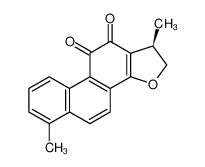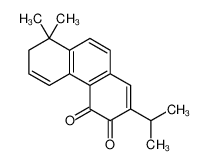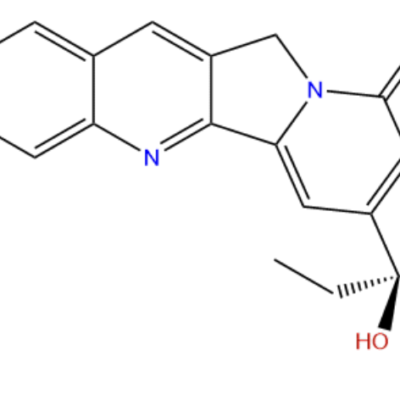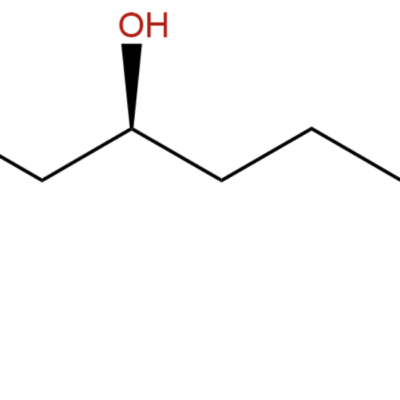$ 150.0
Quantity: 100 MG
In stock
Description
Product name:15,16-Dihydrotanshinone I
Synonym:
Catalog #: BP0027
Purity: 98%
CAS No.:87205-99-0
Molecular Formula: C18H14O3
Molecular Weight: 278.307
Botanical Source:Salvia miltiorrhiza
Analysis Method: HPLC-DAD or/and HPLC-ELSD
Identification Method: Mass, NMR
Packing: Brown vial or HDPE plastic bottle
Descriptions:
Dihydrotanshinone I(DI) and cryptotanshinone, constituents of a medicinal plant, Salvia miltiorrhiza Bunge, have antibacterial activity against a broad range of Gram positive bacteria, they generates superoxide radicals in Bacillus subtilis lysates, the superoxide radicals are important in the antibacterial actions of the agents.[1]
Dihydrotanshinone I induces topoisomerase I-mediated DNA cleavage as strongly as camptothecin, but topoisomerase II-mediated DNA cleavage was not affected, dihydrotanshinone I inhibits the catalytic activity of topoisomerase I by the formation of a cleavable complex and at least in part through the intercalation into DNA.[2]
Dihydrotanshinone I has cytotoxicity to a variety of tumor cells, it induces a potent cytotoxicity to human umbilical vein endothelial cells with an IC 50 value of approximately 1.28 ug/ml; it could inhibit angio-genesis through suppressing endothelial cell proliferation, migration, invasion and tube formation, indicating that DI has a potential to be developed as a novel anti-angiogenic agent.[3]
Dihydrotanshinone I significantly impaires activation of extracellular signal-regulated kinase 1/2 (ERK1/2), p38 and stress-activated protein kinase/c-Jun NH2-terminal kinase (JNK/SAPK), it suppresses the growth of HeLa cells in a xenograft tumor model, which could be correlated with its modulation of TNF-α production, suggests that dihydrotanshinone I could be a valuable candidate for the intervention of NF-κB-dependent pathological conditions such as inflammation and cancer.[4]
Dihydrotanshinone I induces cell growth arrest during the S phase and subsequently, apoptosis, following its application to K562/ADR cells, exhibits cytotoxicity against various tumor cell lines. [5]
Dihydrotanshinone I combines irradiation, which can enhance apoptotic effects in human cervical cancer by HPV E6 down-regulation and caspases activation.[6]
Dihydrotanshinone I and cryptotanshinone exhibit strong inhibition towards human liver microsome (HLM)-catalyzed propofol glucuronidation, and dihydrotanshinone I exhibits strong inhibition towards UDP-glucuronosyltransferase (UGT) 1A7.[7,8]
Dihydrotanshinone-I interferes with the RNA-binding activity of HuR affecting its post-transcriptional function.[9]
Dihydrotanshinone I induces caspase and ROS dependent apoptosis and autophagy, mediated by mitochondria in colon cancer; it could be a promising leading compound for the development of anti-tumor agent or be developed as an adjuvant drug for colon cancer therapy.[10]
Dihydrotanshinone I has inhibitory effects on CYP4A11 and CYP4F3A mediated ω-hydroxylation of arachidonic acid.[11]
References:
[1] Lee D S, Lee S H, Noh J G, et al. Biosci Biotech Biochem, 2014, 63(12):2236-9.
[2] Lee D S, Lee S H, Kwon G S, et al. Biosci Biotech Biochem, 1999, 63(8):1370-3.
[3] Weipeng, Bian, Chen, et al. Acta Bioch Bioph Sin, 2008, 40(1):1–6.
[4] Wang F, Ma J, Wang KS, et al. Int Immunopharmacol, 2015, 28(1):764-72.
[5] Lee D S, Lee S H. J Biosci Bioeng, 2000, 89(3):292-3.
[6] Ye Y, Xu W, Zhong W, et al.Mol Cell Biochem, 2012, 363(1-2):191-202.
[7] Cong M, Hu C M, Cao Y F, et al. Fitoterapia, 2013, 85(1):109-13.
[8] Gong G, Zhang S Y, Lin J J, et al. Latin Am J Pharm, 2012, 31(7):1060-3.
[9] D’Agostino V G, Lal P, Mantelli B, et al. Sci Rep, 2015, 5(3):1392-1215.
[10] Lin W, Tao H, Jing S, et al.Phytomed Int J Phytother Phytopharmacol, 2015, 22(12):1079-87.
[11] Meijuan Xu, Lifeng Jiang, Wenzheng Ju, et al. Eur J Integr Med, 2014, 6(6):735.
[12] Zhu D, Tan S. China Pharmacist, 2008, 11(03):301-3.




